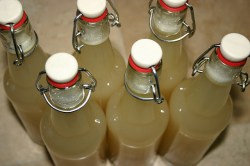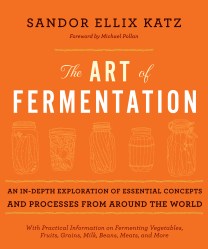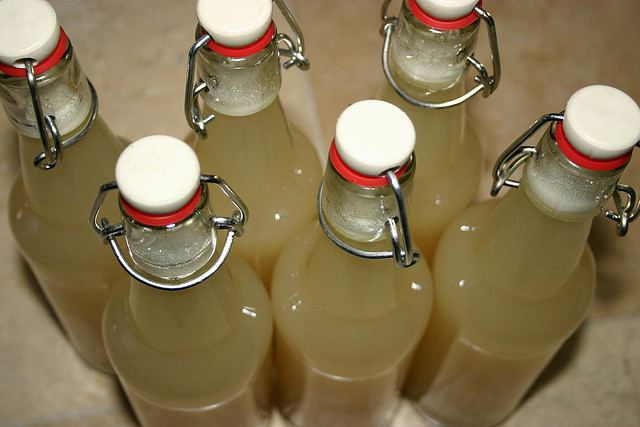
Get a recipe for ginger beer. (Photo by Reese Lloyd.)
Editor’s note: Finally, Sandor Katz — the nation’s fermentation expert — has written a bible-sized book about his craft. Beyond sauerkraut, bread, and beer, The Art of Fermentation: An In-Depth Exploration of Essential Concepts and Processes from Around the World takes readers into the outer realms of the theory and practice behind this edgy, traditional approach to food preservation. What follows is an excerpt from Katz’ introduction, but it can also serve as a kind of manifesto for his work. See Katz’ recipe for homemade ginger beer and “ginger bug” for more on the how-to side of things.
One word that repeatedly comes to the fore in my exploration and thinking about fermentation is culture. Fermentation relates to culture in many different ways, corresponding with the many layers of meaning embedded in this important word, from its literal and specific meanings in the context of microbiology to its broadest connotations. We call the starters that we add to milk to make yogurt, or to initiate any fermentation, cultures. Simultaneously, culture constitutes the totality of all that humans seek to pass from generation to generation, including language, music, art, literature, scientific knowledge, and belief systems, as well as agriculture and culinary techniques (in both of which fermentation occupies a central role).

Sandor Ellix Katz. (Photo by Sean Minteh.)
In fact, the word culture comes from Latin cultura, a form of colere, “to cultivate.” Our cultivation of the land and its creatures — plants, animals, fungi, and bacteria — is essential to culture. Reclaiming our food and our participation in cultivation is a means of cultural revival, taking action to break out of the confining and infantilizing dependency of the role of consumer (user), and taking back our dignity and power by becoming producers and creators.
This is not just about fermentation (even if, as a biological force upon our food, that is inevitable), but about food more broadly. Every living creature on this Earth interacts intimately with its environment via its food. Humans in our developed technological society, however, have largely severed this connection, and with disastrous results. Though affluent people have more food choices than people of the past could ever have dreamed of, and though one person’s labor can produce more food today than ever before, the large-scale, commercial methods and systems that enable these phenomena are destroying our Earth, destroying our health, and depriving us of dignity. With respect to food, the vast majority of people are completely dependent for survival upon a fragile global infrastructure of monocultures, synthetic chemicals, biotechnology, and transportation.
Moving toward a more harmonious way of life and greater resilience requires our active participation. This means finding ways to become more aware of and connected to the other forms of life that are around us and that constitute our food — plants and animals, as well as bacteria and fungi — and to the resources, such as water, fuel, materials, tools, and transportation, upon which we depend. It means taking responsibility for our shit, both literally and figuratively. We can become creators of a better world, of better and more sustainable food choices, of greater awareness of resources, and of community based upon sharing. For culture to be strong and resilient, it must be a creative realm in which skills, information, and values are engaged and transmitted; culture cannot thrive as a consumer paradise or a spectator sport. Daily life offers constant opportunities for participatory action. Seize them.
 Just as the microbial cultures exist only as communities, so too do our broader human cultures. Food is the greatest community builder there is. It invites people to sit and stay awhile, and families to gather together. It welcomes new neighbors and weary travelers and beloved old friends. And it takes a village to produce food. Many hands make light work, and food production often gives rise to specialization and exchange. And even more than food in general, fermented foods — especially beverages — play a significant role in community building. Not only are many feasts, rituals, and celebrations organized around products of fermentation (such as bread and wine), ferments are also among the oldest and most important of the foods that add both value and stability to the raw products of agriculture, essential to the economic underpinnings of all communities. The brewer and the baker are central participants in any grain-based economy; and wine transforms perishable grapes into a stable and coveted commodity, as does cheese for milk.
Just as the microbial cultures exist only as communities, so too do our broader human cultures. Food is the greatest community builder there is. It invites people to sit and stay awhile, and families to gather together. It welcomes new neighbors and weary travelers and beloved old friends. And it takes a village to produce food. Many hands make light work, and food production often gives rise to specialization and exchange. And even more than food in general, fermented foods — especially beverages — play a significant role in community building. Not only are many feasts, rituals, and celebrations organized around products of fermentation (such as bread and wine), ferments are also among the oldest and most important of the foods that add both value and stability to the raw products of agriculture, essential to the economic underpinnings of all communities. The brewer and the baker are central participants in any grain-based economy; and wine transforms perishable grapes into a stable and coveted commodity, as does cheese for milk.
Reclaiming our food means reclaiming community, engaging its economic interconnectivity of specialization and divisions of labor, but at a human scale, promoting awareness of resources and local exchange. Transporting goods around the globe takes a huge amount of resources and wreaks environmental havoc. And while exotic foods can be thrilling treats, it’s inappropriate and destructive to organize our lives primarily around them; most globalized food commodities are grown in vast monocultures, at the expense of forests and diverse subsistence crops. And by being totally dependent on an infrastructure of global trade, we make ourselves exceedingly vulnerable to disruptions for any number of reasons, from natural disasters (floods, earthquakes, tsunamis) and resource depletion (peak oil), to political violence (war, terrorism, organized crime).
Fermentation can be a centerpiece of economic revival. Relocalizing food means a renewal not only of agriculture but also of the processes used to transform and preserve the products of agriculture into the things that people eat and drink every day, including ferments such as bread, cheese, and beer. By participating in local food production — agriculture and beyond — we actually create important resources that can help fill our most basic daily needs. By supporting this local food revival, we recycle our dollars into our communities, where they may repeatedly circulate, supporting people in productive endeavors and creating incentives for people to acquire important skills, as well as feeding us fresher, healthier food with less fuel and pollution embedded in it. As our communities feed ourselves more and thereby reclaim power and dignity, we also decrease our collective dependency on the fragile infrastructure of global trade. Cultural revival means economic revival.
Everywhere I go I meet people who are making the choice to be part of this culture of revival. Perhaps this is exemplified best by the growing number of young people who are choosing to take up farming. The second half of the 20th century saw the near extinction of the tradition of regional food self-sufficiency in the United States and many other places. Today that tradition is in revival. Let us support and become part of it. Productive local food systems are better than globalized food for many reasons: They yield fresher and more nutritious food; local jobs and productivity; less dependence on fuel and infrastructure; and greater food security. We must become more closely connected to the land via our food, and we must have people willing to do the hard physical work of agriculture. Value and reward that work. And get involved with it.
I don’t want to give the impression that this culture of revival is brand-new. There always have been holdouts who resist new technologies, such as farmers who never adopted chemical methods, or never stopped using and saving the legacy of seed resources they inherited, or still use horses in lieu of tractors, or families who have unceasingly maintained fermentation practices. There have always been seekers looking to reconnect to old ways, or unwilling to accept the “conveniences” of modern culture. As much as culture is always reinventing itself in unprecedented ways, culture is continuity. There are always roots.
Cultural revival certainly does not require abandoning cities and suburbs for some remote rural ideal. We must create more harmonious ways of life where people and infrastructures are, and that is mostly cities and suburbs. “Sustainability” or “resilience” cannot be remote ideals you have to go somewhere else to fully realize. They are ethics we can and must build into our lives however we are able to and wherever we find ourselves.
Nearly 20 years ago, I moved from a lifetime in Manhattan to an off-the-grid rural commune in Tennessee, and I’m so glad I did. Sometimes a dramatic change is exactly what you need. I was 30 years old, had recently tested HIV-positive, and was searching for a big change I could not yet imagine, when a chance encounter led me to a communal homestead of queers in the woods. I can personally testify that rural resettlement can be a rewarding path. But rural living is certainly not intrinsically better or more sustainable than city life. In fact, rural dwelling, as most of us (myself included) are practicing it, involves driving frequently to get around. In the city I grew up in, most people do not have cars and get around using mass transit.
Cities are where most people are, and much incredibly creative and transformative work is being done in urban and suburban areas. Urban farming and homesteading are on the rise, flourishing especially in cities with large expanses of abandoned properties. The revival of artisan fermentation enterprises is centered around cities, mainly because they hold the major markets, no matter where production may occur.
The late, great urbanist Jane Jacobs put forth an intriguing theory that agriculture developed and spread from cities rather than rural outposts. In her book The Economy of Cities, Jacobs rejects the prevailing assumption that “cities are built upon a rural economic base,” which she calls the “dogma of agricultural primacy.” Instead she argues that the inherent creativity of urbanism fostered the innovations that spawned (and continually reinvent) agriculture. “The first spread of the new grains and animals is from city to city … The cultivation of plants and animals is, as yet, only city work.” Her basic idea is that a trading settlement that is a crossroads for people migrating from different areas provides a dynamic environment for incidental seed crossing and selective breeding, as well as greater opportunities for specialization and the development and spread of techniques.
If Jacobs’s theory is correct, then fermentation practices must also have urban roots. Rural dwellers may frequently be guardians of inherited legacies such as seeds, cultures, and know-how; however, it is primarily urbanites who are spurring agricultural change in the countryside by creating demand — starting farmers markets and providing the bulk of the community support for what is known as community supported agriculture (CSA). Urbanites can grow gardens and ferment, just as rural dwellers can. They can also tap into the deep currents of creativity that exist in cities, and the inevitable cross-pollination that occurs there, to foster change. That change can incorporate ancient wisdom that is in danger of disappearing, just as much as it can foster innovation.



